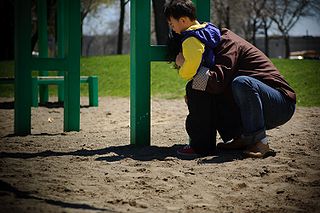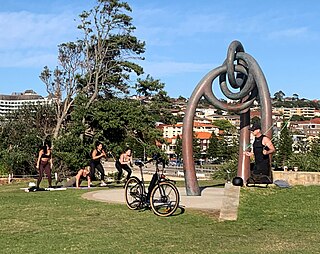Related Research Articles

Croup, also known as laryngotracheobronchitis, is a type of respiratory infection that is usually caused by a virus. The infection leads to swelling inside the trachea, which interferes with normal breathing and produces the classic symptoms of "barking/brassy" cough, inspiratory stridor and a hoarse voice. Fever and runny nose may also be present. These symptoms may be mild, moderate, or severe. Often it starts or is worse at night and normally lasts one to two days.

Enuresis is a repeated inability to control urination. Use of the term is usually limited to describing people old enough to be expected to exercise such control. Involuntary urination is also known as urinary incontinence. The term "enuresis" comes from the Ancient Greek: ἐνούρησις, romanized: enoúrēsis.
International emergency medicine is a subspecialty of emergency medicine that focuses not only on the global practice of emergency medicine but also on efforts to promote the growth of emergency care as a branch of medicine throughout the world. The term international emergency medicine generally refers to the transfer of skills and knowledge—including knowledge of ambulance operations and other aspects of prehospital care—from developed emergency medical systems (EMSs) to those systems which are less developed. However, this definition has been criticized as oxymoronic, given the international nature of medicine and the number of physicians working internationally. From this point of view, international emergency medicine is better described as the training required for and the reality of practicing the specialty outside of one's native country.

Sports medicine is a branch of medicine that deals with physical fitness and the treatment and prevention of injuries related to sports and exercise. Although most sports teams have employed team physicians for many years, it is only since the late 20th century that sports medicine emerged as a distinct field of health care. In some countries, sports medicine is a recognized medical specialty. In the majority of countries where sports medicine is recognized and practiced, it is a physician (non-surgical) specialty, but in some, it can equally be a surgical or non-surgical medical specialty, and also a specialty field within primary care. In other contexts, the field of sports medicine encompasses the scope of both medical specialists as well as allied health practitioners who work in the field of sport, such as physiotherapists, athletic trainers, podiatrists and exercise physiologists.

Ludwig's angina is a type of severe cellulitis involving the floor of the mouth and is often caused by bacterial sources. Early in the infection, the floor of the mouth raises due to swelling, leading to difficulty swallowing saliva. As a result, patients may present with drooling and difficulty speaking. As the condition worsens, the airway may be compromised and hardening of the spaces on both sides of the tongue may develop. Overall, this condition has a rapid onset over a few hours.

Kamran Abbasi is the editor-in-chief of the British Medical Journal (BMJ), a physician, visiting professor at the Department of Primary Care and Public Health, Imperial College, London, editor of the Journal of the Royal Society of Medicine(JRSM), journalist, cricket writer and broadcaster, who contributed to the expansion of international editions of the BMJ and has argued that medicine cannot exist in a political void.
Acute medicine is a specialty within internal medicine concerned with the immediate and early specialist management of adult patients with a wide range of medical conditions who present in hospital as emergencies. It developed in the United Kingdom in the early 2000s as a dedicated field of medicine, together with the establishment of acute medical units in numerous hospitals. Acute medicine is distinct from the broader field of emergency medicine, which is concerned with the management of all people attending the emergency department, not just those with internal medicine diagnoses.

In medicine, the Ottawa ankle rules are a set of guidelines for clinicians to help decide if a patient with foot or ankle pain should be offered X-rays to diagnose a possible bone fracture. Before the introduction of the rules most patients with ankle injuries would have been imaged. However the vast majority of patients with unclear ankle injuries do not have bone fractures. As a result, many unnecessary X-rays were taken, which was costly, time-consuming and a slight health risk due to radiation exposure.

The Fellowship of Postgraduate Medicine (FPM) is a British non-profit organisation that was founded after World War I and pioneered the development of postgraduate educational programmes in all branches of medicine. It was founded in late 1918 as the Inter-allied Fellowship of Medicine with Sir William Osler as its president. In the autumn of 1919, Osler merged the IAFM with the Postgraduate Medical Association of which he had been the founding President since 1911. In October 1919, Osler was appointed President of the combined Fellowship of Medicine and the Postgraduate Medical Association and Sir William Osler became the first president of the new organisation. The fellowship is supported by national and international fellows with expertise in the practice of medicine, medical education, clinical research, and related disciplines. The office and meeting rooms of the fellowship are in Central London. It is governed by a council that meets quarterly.

Paracetamol poisoning, also known as acetaminophen poisoning, is caused by excessive use of the medication paracetamol (acetaminophen). Most people have few or non-specific symptoms in the first 24 hours following overdose. These symptoms include feeling tired, abdominal pain, or nausea. This is typically followed by absence of symptoms for a couple of days, after which yellowish skin, blood clotting problems, and confusion occurs as a result of liver failure. Additional complications may include kidney failure, pancreatitis, low blood sugar, and lactic acidosis. If death does not occur, people tend to recover fully over a couple of weeks. Without treatment, death from toxicity occurs 4 to 18 days later.
St. Emlyn’s is a virtual hospital developed by educationalists based at the Manchester Royal Infirmary, England. It incorporates online learning materials, a blog, and a podcast.

Choosing Wisely is a United States-based health educational campaign, led by the ABIM Foundation, about unnecessary health care.

The International Federation for Emergency Medicine (IFEM) is an organisation promoting international emergency medicine around the world. It is a consortium of over 70 national and regional emergency medicine organisations. IFEM organises the International Conference on Emergency Medicine (ICEM).
The World Association for Disaster and Emergency Medicine (WADEM) is an international organization concerned with disaster medicine. Originally named the Club of Mainz, it was founded on October 2, 1976. It has hosted the World Congress on Disaster and Emergency Medicine every two years since 1979. Additionally, it publishes the peer-reviewed journal Prehospital and Disaster Medicine.
The relationship between antidepressant use and suicide risk is a subject of medical research and has faced varying levels of debate. This problem was thought to be serious enough to warrant intervention by the U.S. Food and Drug Administration to label greater likelihood of suicide as a risk of using antidepressants. Some studies have shown that the use of certain antidepressants correlate with an increased risk of suicide in some patients relative to other antidepressants. However, these conclusions have faced considerable scrutiny and disagreement: A multinational European study indicated that antidepressants decrease risk of suicide at the population level, and other reviews of antidepressant use claim that there is not enough data to indicate antidepressant use increases risk of suicide.
The European Society for Emergency Medicine (EUSEM) is an organisation promoting international emergency medicine in Europe. The society was founded at the International Conference on Emergency Medicine in May 1994 in London. EUSEM brings together over 30 European national societies of emergency medicine. EUSEM hosts pan-European emergency medicine training, examinations and awards. It also publishes the European Journal of Emergency Medicine, and organises annual scientific meetings.

Suresh Samuel David is an Indian physician specializing in emergency medicine. The first Indian physician to be formally trained in emergency medicine, David pioneered the practice of emergency medicine in India and is credited with founding the department of emergency medicine at Christian Medical College, Vellore. He is the first person to hold the position of a professor in the discipline of Emergency Medicine in India.

Exercise medicine is a branch of medicine that deals with physical fitness and the prevention and treatment of injuries and illness with exercise. In some countries, Sport and Exercise Medicine (SEM) is a recognized medical specialty. Exercise medicine is therefore an emerging physician (non-surgical) specialty, but there is also a belief that exercise is treatment of such fundamental benefit that it should be incorporated into all medical specialties. Allied health practitioners also can specialize in exercise such as exercise physiologists, physiotherapists, athletic trainers and podiatrists.
Adrian Boyle is a British consultant and emergency physician at Addenbrooke's Hospital, Cambridge, England. In October 2022 he succeeded Katherine Henderson as the President of the Royal College of Emergency Medicine.
References
- 1 2 3 4 "International Conference on Emergency Medicine". International Federation for Emergency Medicine. International Federation for Emergency Medicine. Retrieved 7 April 2018.
- 1 2 Bodiwala, Gautam (2007). "Emergency Medicine: A global specialty". Emergency Medicine Australasia. 19 (4): 287–8. doi: 10.1111/j.1742-6723.2007.00989.x . PMID 17655627.
- ↑ Neill, A; Cronin, JJ; Brannigan, DD; O'Sullivan, R; Cadogan, M (2013). "The impact of social media on a major international emergency medicine conference". Emergency Medicine Journal. BMJ Journals. 31 (5): 1–10. doi:10.1136/emermed-2012-202039. PMID 23423992. S2CID 25997055.
- ↑ Alagappan, Kumar; Holliman, C. James (2005). "History of the Development of International Emergency Medicine". Emergency Medicine Clinics of North America. W. B. Saunders Company. 23 (1): 1–10. doi:10.1016/j.emc.2004.09.013. PMID 15663970.
- ↑ "Past ICEMs". International Federation for Emergency Medicine. Archived from the original on 18 November 2012. Retrieved 8 August 2013.
- ↑ "International Conference on Emergency Medicine". International Federation for Emergency Medicine. Retrieved 8 August 2013.
- ↑ "First Conference on Emergency Medicine". Archives of Emergency Medicine. 3 (1): 31–92. 1986. doi:10.1136/emj.3.1.31-b. PMC 1285317 . PMID 3730073.
- ↑ Goldman, Brian (1990). "Third world issues provide sobering backdrop as emergency physicians meet". Canadian Medical Association Journal. 143 (11): 1229, 1232–1233. PMC 1452859 . PMID 1977510.
- ↑ Chan, JW; Graham, CA (2011). "Full text publication rates of studies presented at an international emergency medicine scientific meeting". Emergency Medicine Journal. BMJ Publishing Group. 28 (9): 802–803. doi:10.1136/emj.2010.101667. PMID 20844093. S2CID 24164214.
- ↑ "International Conference on Emergency Medicine". EHS Today. 6 March 2008. Retrieved 8 August 2013.
- ↑ Klassen, TP; Acworth, J; Bialy, L; Black, K; Chamberlain JM, JM; Cheng, N; Daiziel, S; Fernandes, RM; Fitzpatrick, E; Johnson, DW; Kuppermann, N; Macias, CG; Newton, M; Osmond, MH; Plint, A; Valerio, P; Waisman, Y (2010). "Pediatric emergency research networks: a global initiative in pediatric emergency medicine". Pediatric Emergency Care. 26 (8): 541–543. doi:10.1097/PEC.0b013e3181e5bec1. PMID 20657343. S2CID 34210456.